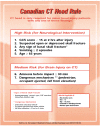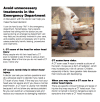Checklist for Head Injury Management Evaluation Study (CHIMES): a quality improvement initiative to reduce imaging utilisation for head injuries in the emergency department
- PMID: 32019751
- PMCID: PMC7011890
- DOI: 10.1136/bmjoq-2019-000811
Checklist for Head Injury Management Evaluation Study (CHIMES): a quality improvement initiative to reduce imaging utilisation for head injuries in the emergency department
Abstract
Over 90% of patients with head trauma seen in emergency departments (EDs) are diagnosed with minor head injuries. Over-utilisation of CT scans results in unnecessary exposure to radiation and increases healthcare utilisation. Using recommendations from the Choosing Wisely Canada (CWC) campaign and quality improvement (QI) methodology, we aimed to reduce the CT scan rate for head injuries by 10% over a 6-month period.Baseline CT scan rates were determined through a 27-month retrospective cohort review. We used stakeholder engagement and provider surveys to develop our driver diagram and Plan-Do-Study-Act (PDSA) cycles, which included (1) improving provider knowledge about the CWC campaign recommendations; (2) testing, refining and implementing a modified Canadian CT Head Rule checklist; (3) developing CWC-themed head injury-specific patient handouts; and (4) feedback on CT scan group ordering rates to providers. Our primary outcome measure was the number of CT scans performed for patients with head injuries. Process measures included the number of checklists completed and ED length of stay (LOS). Our balancing measure was return ED visits within 72 hours (with or without admission).Baseline CT scan rates prior to our interventions was 46.1%. Our QI initiative resulted in a 'shift' in the Statistical Process Control chart of the weekly CT scan rates, associated with the first and second PDSA cycles, resulting in a 13.9% reduction in CT rates during the initial 3 months, and a sustained reduction of 8% at 16 months (p<0.05). Mean ED LOS for all patients with head injuries decreased by 1.5 min (p=0.74). 33% of checklists were completed. 72-hour return visits did not change significantly (p=0.68).Through provider and patient education, and the creation of a user-friendly evidence-based tool, our local QI initiative was successful in achieving long-term reduction in CT rates for patients presenting to EDs with head injuries.
Keywords: PDSA; emergency department; quality improvement.
© Author(s) (or their employer(s)) 2020. Re-use permitted under CC BY-NC. No commercial re-use. See rights and permissions. Published by BMJ.
Conflict of interest statement
Competing interests: None declared.
Figures









References
-
- An initiative of the ABIM Foundation Choosing Wisely. Available: http://www.choosingwisely.org/clinician-lists/ [Accessed 1 Sep 2018].
-
- Canadian Association of Emergency Physicians Choosing Wisely Canada: emergency medicine: ten things physicians and patients should question, 2017. Available: https://choosingwiselycanada.org/wp-content/uploads/2017/02/Emergency-Me... [Accessed 01 Sep 2018].
MeSH terms
LinkOut - more resources
Full Text Sources
Medical
